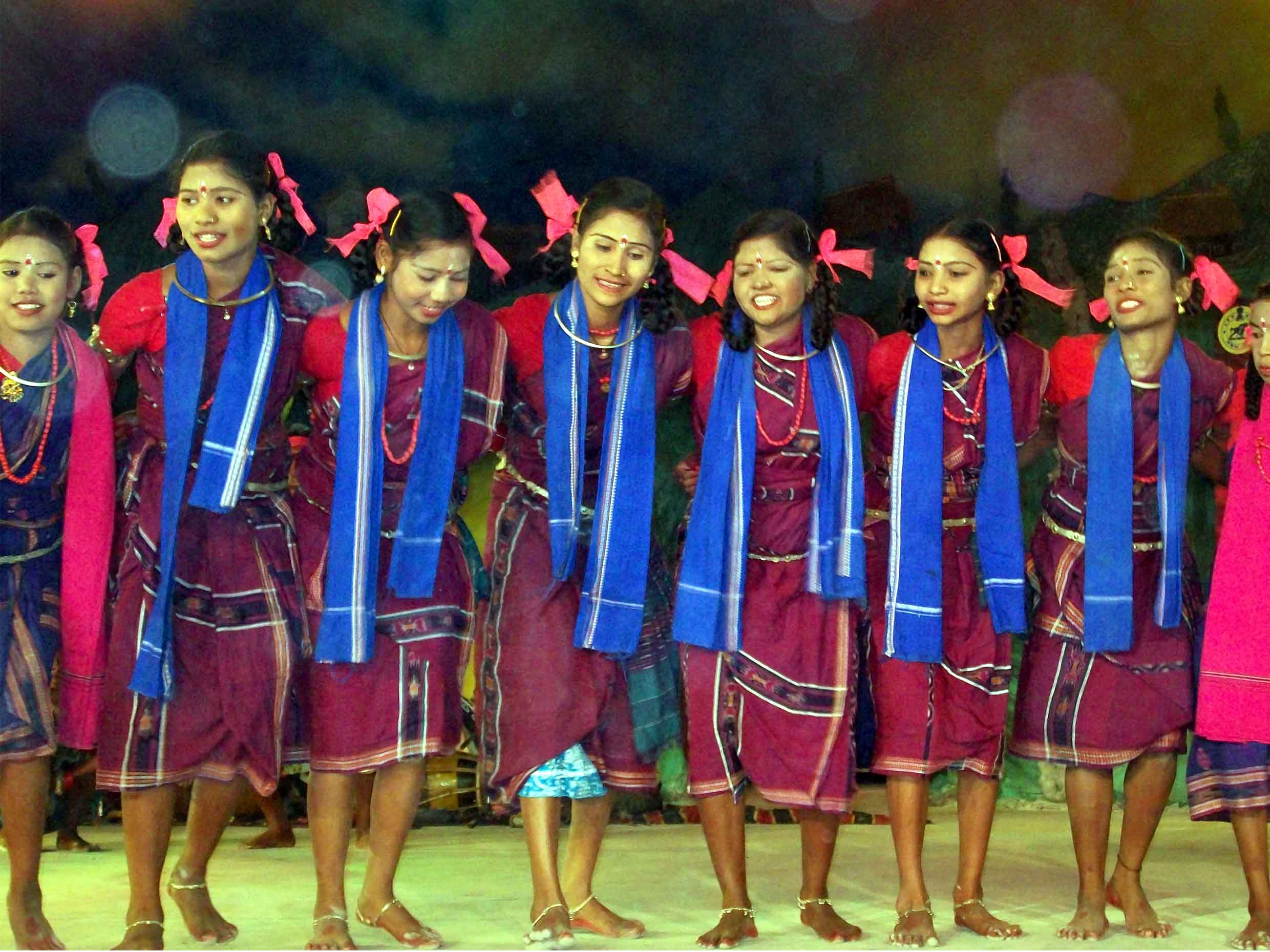In the month of Aswina, on the Mahaastami day of Durga Puja, people of Western Orissa celebrate Bhai Juntia. A total fasting is observed by young girls and women for the entire day and night to seek the blessings of Goddess Durga for amelioration and long life of their brothers. In villages young girls usually dance in small groups during this celebration which is known as Dalkhai dance. Dalkhai is a ritual-based folk dance which is accompanied by several musical instruments as well.
Dalkhai is basically a folk deity. Her abode is known as Dalkhai kuthi. The name Dalkhai is derived from the name of the deity as the dance is performed in her name. In the past, people worshipped the jungle deity to protect themselves from the wild animals and other dangers. Afterwards the deity became synonymous with Durga or Bana Durga. Usually through this dance they pray for the general happiness of the family and the village as a whole.
On the Durga Astami day young girls assemble on the bank of a river or a pond to take bath. One of them brings seven palm-full of sands and built a small platform for worship, they put four mango leaf and place burning wicks on them. This ritual is repeated seven times as seven girls bring palm-full of water and follow the same ritual. Thereafter prayers are offered to goddess Dalkhai for the well-being of their brothers. This is followed by songs and dances, where all the people – young or old – participate with equal enthusiasm. Earlier during the dance, young girls and boys join together in a question answer session.
In the afternoon, at Pantibela, all the girls assemble near the Dalkhai Kuthi with their baskets containing sand and other materials for worship. Some of them get dressed like Parvati and Iswara, while the rest of them carry umbrella, a stick and a water jug (Kalsi). In a procession they move to seven houses and come back to the Dalkhai Kuthi. Inside the Dalkhai Kuthi they perform several acts of the mythology. One of them acts as Bhima and some other act as Kubera. Bhima brings paddy from Kubera and sows it in the field. Songs and dances enacting various scenes from the mythology are essential part of Dalkhai.
Returning home the girls prepare for further rituals. They prepare leaf cups containing piece of sugarcane, yellow thread called 멽ita?, 108 pieces of duba (evergreen grass), 108 pieces of unbroken rice; along with it small branches of Amla and Dahana (a sweet smelling leaf), puffed rice and dhup are placed. Separate leaf cups are arranged for each brother.
After taking bath in the river bank they prepare platform for worship. Fruits like ladies finger, frankincense (Kunduru) etc. are placed as offerings to the goddess Dalkhai. Then they change their clothes and carry their baskets and assemble near the Dalkhai Kuthi. They collect seven clay statues of Parvati, Iswara, Ganesha, Tortoise and Bull are placed inside the Dalkhai Kuthi. The ritual starts with Dhunkel and Bharni beat of the dhol. It is often seen that a person becomes possessed by a spirit of one of the deities. The villagers ask several questions regarding the wellbeing of the village. The ritual then comes to an end.
On the ninth day, all the girls again assemble near the Dalkhai Kuthi. After collecting all the articles used for the ritual on the previous day, they move in a procession accompanied by drumming of dhol and nissan to seven houses and then to the river bank to immerse all the articles. After taking bath they return home, and the 108 dub, 108 rice and yellow thread are offered to their brothers. Till the end of the tenth day of Dasahara, they are engrossed in Dalkhai dance. The entire village plunges into an energetic mood by the intoxicating effect of the melodious song and dance.
Dalkhai is performed as a ritual, whereas dance and song remains its principal interest. The dancers stand in a semi-circular formation during the dance. One after another they sing a couplet and at the end of it they dance in a particular way by bending at the waist level and move their feet rhythmically accompanied by musical instruments.
During the song dhol is played and subsequently other musical instruments like Nishan, Tasha, Jhanj and Muhari are accompanied.
The songs are composed from couplets to sixteen lines. The singer begins the song uttering “Dalkahi Re, Dalkahi Re” (twice) and finishes the lines with another pronouncement of “Dalkahi Re”. Mostly the songs are of romantic themes. At times one can find the description of nature, seasons, gods and goddesses; sometimes satire and teasing also. The singers have to depend entirely on their memory while rendering the songs – presence of mind comes handy.
During rendering Dalkhai usually Raserkeli, Mailajada, Jaiphul are also rendered. The lyrical depiction of Rasarkeli, MaelaJada and Jaiphula may look similar with Dalkhai. However, the song and rhythm of drums has different beats and style.



